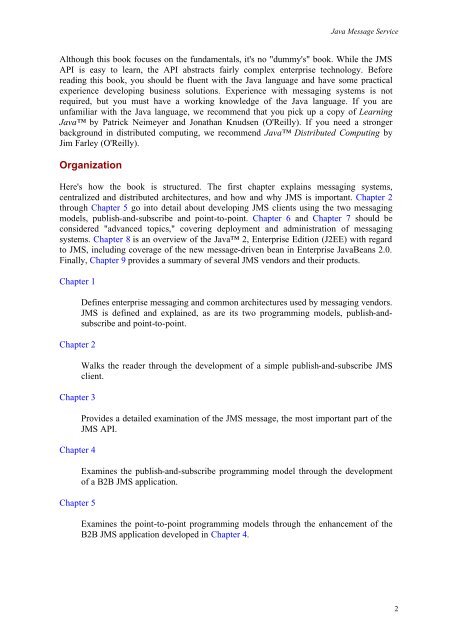O'Reilly - Java Message Service
O'Reilly - Java Message Service
O'Reilly - Java Message Service
You also want an ePaper? Increase the reach of your titles
YUMPU automatically turns print PDFs into web optimized ePapers that Google loves.
<strong>Java</strong> <strong>Message</strong> <strong>Service</strong><br />
Although this book focuses on the fundamentals, it's no "dummy's" book. While the JMS<br />
API is easy to learn, the API abstracts fairly complex enterprise technology. Before<br />
reading this book, you should be fluent with the <strong>Java</strong> language and have some practical<br />
experience developing business solutions. Experience with messaging systems is not<br />
required, but you must have a working knowledge of the <strong>Java</strong> language. If you are<br />
unfamiliar with the <strong>Java</strong> language, we recommend that you pick up a copy of Learning<br />
<strong>Java</strong> by Patrick Neimeyer and Jonathan Knudsen (<strong>O'Reilly</strong>). If you need a stronger<br />
background in distributed computing, we recommend <strong>Java</strong> Distributed Computing by<br />
Jim Farley (<strong>O'Reilly</strong>).<br />
Organization<br />
Here's how the book is structured. The first chapter explains messaging systems,<br />
centralized and distributed architectures, and how and why JMS is important. Chapter 2<br />
through Chapter 5 go into detail about developing JMS clients using the two messaging<br />
models, publish-and-subscribe and point-to-point. Chapter 6 and Chapter 7 should be<br />
considered "advanced topics," covering deployment and administration of messaging<br />
systems. Chapter 8 is an overview of the <strong>Java</strong> 2, Enterprise Edition (J2EE) with regard<br />
to JMS, including coverage of the new message-driven bean in Enterprise <strong>Java</strong>Beans 2.0.<br />
Finally, Chapter 9 provides a summary of several JMS vendors and their products.<br />
Chapter 1<br />
Chapter 2<br />
Chapter 3<br />
Chapter 4<br />
Chapter 5<br />
Defines enterprise messaging and common architectures used by messaging vendors.<br />
JMS is defined and explained, as are its two programming models, publish-andsubscribe<br />
and point-to-point.<br />
Walks the reader through the development of a simple publish-and-subscribe JMS<br />
client.<br />
Provides a detailed examination of the JMS message, the most important part of the<br />
JMS API.<br />
Examines the publish-and-subscribe programming model through the development<br />
of a B2B JMS application.<br />
Examines the point-to-point programming models through the enhancement of the<br />
B2B JMS application developed in Chapter 4.<br />
2
















